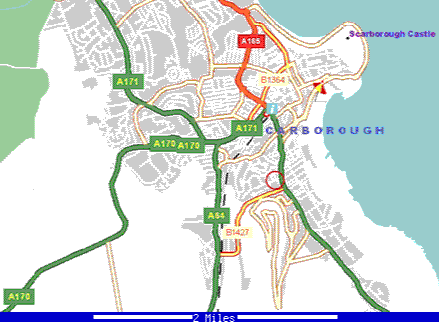 |
 ; ; |
| Left and above: Maps locating 7 Princess Royal Terrace, Scarborough |
1805 Info 8j: John Henry Crompton
|
We could not believe we were expected to attack in such appalling conditions. I never prayed so much in all my life. I got down in the mud and prayed for God to bring me through. My whole life went before me and I couldn't see the future'.
Pat Burns, Pte, 46th Canadians, October 1917 (Source: In Flanders Field Museum, Ypres)
John Henry was initially recorded as 'Wounded in action' on 10 October 1917 and then'Reported wounded and missing' on 17 December 1917 but it wasn't until 7 May 1918 that he was reported as 'Killed in Action'. The Court of Enquiry, held on 13 June 1918, recorded only that he was 'Previously reported wounded and missing [in] Belgium'.
The long process of posting John Henry as 'Killed in Action', and of giving a finality to the family, is illustrated by the correspondence between Margaret CROMPTON, John Henry's sister, living at 7 Princes Royal Terrace, Scarborough, and the Australian Red Cross Society (ARCS), based in 36 Grosvenor Place, London. The file contains 'official' letters which would not have been sent to Scarborough. An illustrative selection of the correspondence is shown below.
Source: Australian War Memorial - Red Cross database (Accessed 19 December 2017)
 |
 ; ; |
| Left and above: Maps locating 7 Princess Royal Terrace, Scarborough |
At sometime between 4 October 1917 and 12 November 1917 the Commanding Officer of the 42nd Battalion, or his representative (there had been 223 Battalion casualties on 4 October) had written to Margaret Elizabeth Williams, as next of kin, informing her that her son had been wounded. It is assumed that, since no direct news had been received John Henry's sister contacted the ARCS on 12 November 1917, expressing the family's natural anxiety.
In reply to the ARCS's inquiry the 42nd Battalion's Adjutant, in the cold December front line around Jesus Farm in the Armentieres sector, confirmed that John Henry had been sent to the hospital at Trouville. However, the ARCS's attempts to find him, or even trace him, were unsuccessful. They hinted at a classification of 'Missing in Action'. The 42nd Battalion reported on 4 January 1918 that John Henry 'was last heard of at Trouville Hospital, France. His present whereabouts is unknown.' On 1 February 1918 the ARCS wrote saying that John Henry was 'now officially reported as Wounded and Missing since 4.10.17.' By 'assuring [the family of their] sympathy' the ARCS hinted at what was to come.
 |
| Above: A map locating Trouville - assumed to be the 42nd Battalion's evacuation hospital |
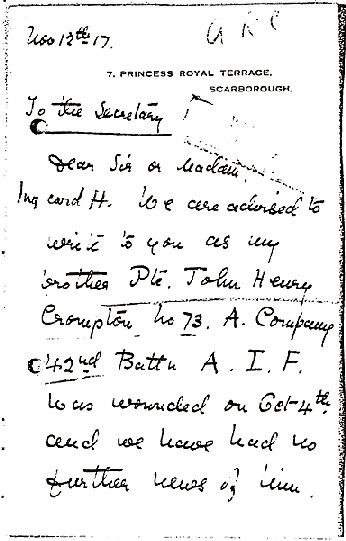 |
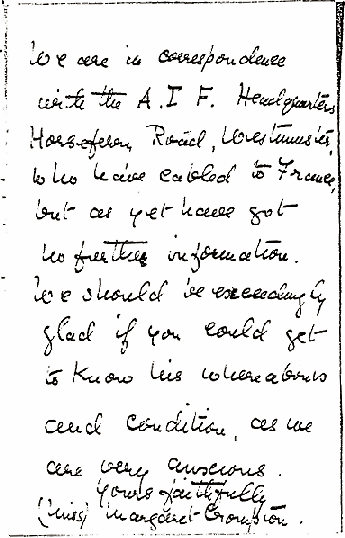 |
 |
The ARCS began to take statements from witnesses in the 42nd Battalion. The first statement was from No 118 Pte Herbert Cecil Haines who, because of the close proximity of his service number to John Henry's, would have joined the 42nd on or slightly after 6 December 1915. There is a feeling of camaraderie built, over time, from the recruitment days in the Enoggera Barracks, Brisbane, and on board HMAT Borda.
 |
| Above: ARCS witness letter from Pte Harris |
I suspect that this account, given to the ARCS, was uncensored and relatively accurate, being only five months after the event. It gives a very precise location of John Henry's position, when first wounded, and locates his grave in a narrow strip of land between Alma Farm and the Ypres to Roulers railway. Post attack photographs show that the railway embankment was almost level with the surrounding swamp. It is understandable why the marked grave was never found. A signal from the 42nd Battalion to 11th Brigade headquarters, at 9.30am, reports heavy shelling of the railway line by enemy 5.9" guns in Passchendaele. Source: 11 th Brigade War Diaries TNA WO95/3425, Kew, London p.89
| Right: A general view of Zonnebeke Station showing the total destruction of the area. |  |
Pte Haines made two other witness statements on 3 June 1918 and 1 October 1918, which contained both additional and conflicting information.
The ARCS forwarded all the witness statements to Scarborough. Later there appears to have been direct correspondence between Pte Haines and John Henry's family, with the possibility of Pte Haines visiting Scarborough when on leave.
No 118 Pte Herbert Cecil Haines survived the Battle of Amiens (8 August 1918) and the actions on the approach to the Hindenburg Line. Perhaps he was fortunate to have again been hospitalised by the time the Hindenburg Line was attacked on 29 September 1918 to 4 October 1918. He returned to Australia on 18 February 1919.
No. 2587 Cpl. D Bowden, John Henry's section leader in No. 4 Platoon, provided a witness statement on 26 August 1918, from Clayton Court Hospital, Aldershot. He recorded that John Henry:
Based on these reports the 42nd Battalion declared John Henry as 'Killed in Action'. Promptly, a day later, the ARCS notified Margaret CROMPTON. There is no recorded acknowledgement of this letter.
 |
 |
Margaret's short 'Post It' size reply of 3 June 1918 acknowledges Miss Law's letter and concludes:
'We shall be very glad to have the details of my dear brother it [sic] is some little comfort to know that his sufferings are over.'
The final letter from Scarborough, dated ten months after the battle, applauds the efforts of the ARCS despite the passage of time and the outcome. Perhaps the holiday in Cornwall was much needed.
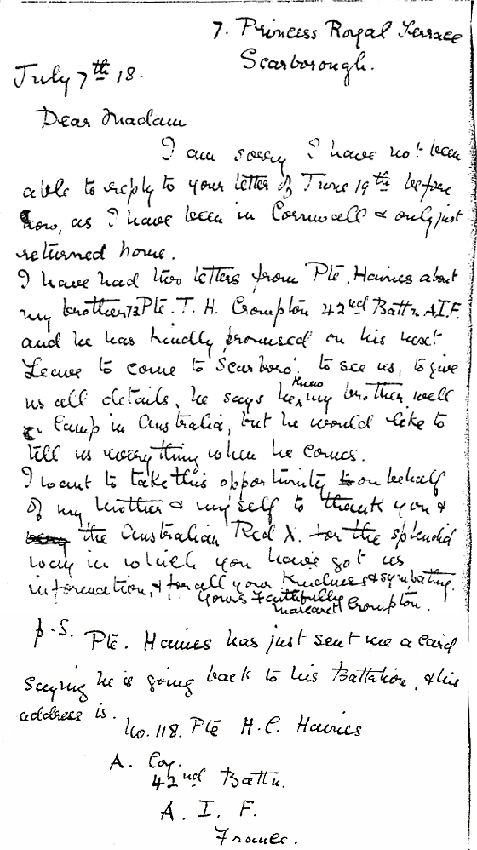
The file contains four later letters, the last dated 1 October 1918, all of which deal with witness statements. However the last letter from the ARCS concludes:
'We are continuing our enquiries although we fear that, as so many months have elapsed since his casualty there is little hope of obtaining definite information of your brother's death.
Assuring you of our sincere sympathy.'
Reading the letters and looking at the handwriting suggests that both Margarets were forceful and forthright people - note the common crossing of the letter 't' and the careful crossings-out. Miss Margaret, who as the youngest surviving daughter, appears to have stayed at home and has made the search for John Henry a focus in her life. Her use of language and her style suggests that she is an educated person, able to write on equal terms with officialdom in an open, honest and straight forward manner. She knows who she is and perhaps a different person from her travelling brother.
The formal letters, though consolatory, contain the platitudes of an officialdom responsible for many thousand of such letters. However, one wonders whether these and the testimony of Cpl. Haines were written for the benefit of the grieving relatives. Would someone wounded in the shoulder be stretchered from the battlefield or be 'walking wounded'? Would Haines have seen the results of the fatal shell or have had time to bury the body and mark the grave?
And finally Cpl. Haines writes that John Henry 'was from Queensland'. Had he lost his Englishness in his travels? Was this a true accolade for a fallen ANZAC?
The processing of his will began on 25 May 1918 but wasn't really resolved until the Officer in Charge, Base Records Office at the Department of Defence, in Melbourne, issued a death certificate on 2 October 1918 which recorded '... was killed in action (No records available) 4th October 17 cable No.C.I.B.L., from Commandant A.I.F. headquarters, dated London 21st May 1918.'
The Australian War Memorial records show a postcard, dated 29 November 1918, addressed to:
Officer Commanding, AIF Kit Store, 110, Greyhound Road, Hammersmith, London W.6
I hereby acknowledge the receipt of package, No, D/S 45832
containing the effects of the late 73. Private JH Crompton, 42nd Battalion Aus. Imp. Force
Signature Mrs ME Williams
Address 7 Princess Royal Terrace, Scarborough
Date Nov 29th 1918
Margaret Elizabeth crossed out her first handwritten note before endorsing the card ...
'With many thanks. I will write to the officer in charge for copy of the will. ME Williams'
| At some date after 18 November 1918 The 1914/15
Star, The British War Medal, and the Victory Medal were confirmed.
Then finally, on 4 November 1922, Margaret Elizabeth Williams, now living at 18 Kingswood Avenue, High West Jesmond, Newcastle-on-Tyne, received The Australian National Memorial Plaque, Memorial Scroll and 'Where the Australians Rest'. |
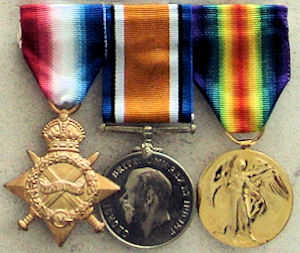 |
| Right: Replicas of John Henry's medal ribbons displayed against the Portland Stone of the Menin Gate, Panel 27 |
John Henry's brother, Walter CROMPTON left his few possessions and a little money to his nieces Leila CROMPTON and Ruthie COOPER nee CROMPTON. When Peter COOPER went to Walter's funeral, in Newcastle, he was handed a small case of possession, which contained John Henry's bronze Memorial Plaque. This had been sent to his mother, Margaret Elizabeth DUGGLEBY/CROMPTON/WILLIAMS, at 18 Kingswood Avenue, High West Jesmond, Newcastle-on-Tyne, which was Walter's home.
| It was decided during World War One that all next of kin of service personnel who lost
their lives as a result of the war would be presented with a Memorial Plaque, cast in
bronze and approximately five inches (125 mm) in diameter. On the plaque itself no rank
was recorded as the intention was to show equality in their sacrifice.
The troops referred to them as "The Dead Man's Penny". Right: John Henry's Dead Man's Penny at the approximate actual size In addition The Memorial pack contained an official letter, the commemorative Scroll, from the King and country, and a "personal" letter from the King. Examples, given to members of the AIF, are shown below. |
 |
 |
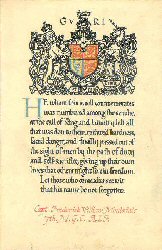 |
 |
||
| Click on the image for a larger picture | ||||
'At that time it was a vast expanse of mud and watery shell-holes, the mud-lined prison of the living, the mud-covered tombs of the dead. So thick were the shell- holes of water that in places where they had overflowed and joined small lakes existed, and where the artillery fire had churned it up was nothing but morass. Places marked on the map had disappeared in the mud; some bare bones of Zonnebeke church still emerged, but almost the only other landmarks were the dozens of concrete "pill-boxes". Where the fight had been thickest the bodies of the dead protruded, their clothes so covered with mud that dead friend and dead foe were indistinguishable one from another. The popular conception of Hell was once Fire, but Dante's "Inferno" describes part of the tower regions as a sea of ice where enemies frozen in the ice gnaw furiously at one another's skulls. And to us who fought at Ypres Dante's awful picture is reduced to a dull mono-chrome compared with the sight of two armies of the white race fighting furiously amid a sea of mud in a struggle of extermination.'
Source: Green FC, 'The Fortieth - a record of the 40th Battalion, A.I.F', The Naval and Military Press, Uckfield, 2007 (Reprint), page 95
Siegfried Sassoon could easily have been describing John Henry's fate when he wrote:
'... I died in Hell
(they called it Passchendaele) my wound was slight
and I was hobbling back; and then a shell
burst slick upon the duckboards; so I fell
into the bottomless mud, and lost the light'
 |
After the War
John Henry was, according to the witness, buried in a marked grave by the Ypres to Roulers railway. However, even marked graves were disrupted by subsequent artillery fire, the weather and carrion. Bodies, with their identification marks, were lost. After the War 8559 ex-infantrymen of the Exhumation Units, of the Directorate of Graves Registration and Enquiries, formed into Exhumation Companies to search the battlefields according to a set procedure. The battle field was divided in to sections of 500 yards2 on to which information from the burial sheets were added. Survey officers marked these squares with flags.
Squads of 32, working in fours, with two pairs of rubber gloves, two spades, a pair of pliers, stakes to mark the grave, tarpaulin and rope to wrap the body, stretchers and the dangerous disinfectant cresol. Each grid was searched at least six times and all possible graves were marked. Sharpened machine-gun cleaning rod were used to prod the earth where clues indicated a body or bodies could be buried there. For example: rifles or stakes protruding from the ground bearing helmets or equipment; partial remains and equipment that had come to the surface; small bones and pieces of equipment brought to surface near to rat-holes; sudden concentrations of wild and vivid green grass, blue-grey-black soil or greenish-black water.
| Right: Annotated map showing that 42 bodies were recovered from the 500 yard
2, where John Henry was buried, in the first 1919 sweep of the battlefield
Click on the map to open a 344 kB jpg casualty map for the battlefields of 4 and 12 October 1917. Note the 544 bodies exhumed from the Bellevue square. It was the machine guns at Bellevue that stalled the AIF's 40th Battalion and the New Zealanders on 12 October 1917. Map source: British 1:40,000 sheet 28 Ypres, showing the number of bodies collected after the war from each 500-yard square, Imperial War Museum/Western Front Association M.5-000756 |
 |
Text source:
Terry Carter in The Long Long Trail (Accessed 19 December 2017)
Bostyn, 2007 pp.223-230
The first photograph shows 'an officer in a mackintosh signing a register held by a sergeant major while the remainder of the party are busy with exhumation. They did what they could to identify bodies, searching necks and wrists for discs or bracelets, and sometimes finding legible papers or an engraved watch.' Source: Holmes, page 228 Remains once discovered were put onto cresol soaked canvas for a careful identification. If any uniform remained, pockets were searched and badges and buttons identified. Sometimes name engraved knives, forks and spoons were placed down the puttees. If the remains were deemed to be an officer (Bedford cord breeches and privately bought army boots being a good indication) and the skull or jawbone was intact then a dental record of the teeth and fillings were consulted.
By May 1920 the Exhumation Units had recovered more than 130,000 bodies. By 24 June 1921 there was only one company of 400 men, still operating.
Hoverbox Photo Gallery - Work of the Graves Registration Unit
This feature does not function correctly on phones and tablets
|
1. Looking for bodied IWM Q100913 2. Finding the remains IWM Q100630 |
3. Gathering the remains on a canvass IWM Q100915 4. Remains wrapped in sacking |
| 1 | 2 | 3 | 4 |
|---|
Hoverbox Photo Gallery - Work of the Graves Registration Unit
This feature does not function correctly on phones and tablets
|
1. Remains on the move 2. Burial parties |
3. Tyne Cot before the stone headstones IWM Q100926 4. Post 1920 IWGC team |
| 1 | 2 | 3 | 4 |
|---|
 |
Tyne Cot Cemetery ... with almost 12,000 graves [is] the largest War Graves
Commission's cemetery anywhere in the world, was developed from a tiny scattering
of graves behind a German bunker used as an aid post. Its consolidation [was] still in
progress, [with] the Commission's standardised wooden crosses. Source:
Holmes, p.229
Left: Tyne Cot Cemetery in 1920 showing the original uniform grave markings and the distinct German bunker |
Of the 11,961 burials at Tyne Cot 1,372 are Australians. Of these 563 have not been identified, 363 partially identified and only 180 identified. The un-identified 'British' graves are marked 'A Soldier of the Great War - Known unto God'. However, Australians were easier to identify because of their distinct clothing and footwear. (Source: Bostyn, 2007, page 286, after F. Descamps)
If John Henry's body has been found it has been buried as one of the nameless' An Australian soldier of the Great War. Known unto God' in Tyne Cot Farm Cemetery: it being the closest to Alma Farm.
| On 4 October 2007 the remains of five Australian soldiers, who died during the Battle
of Passchendaele, were re-interred at New British Cemetery, in Polygon Wood near Zonnebeke.
The five, including Sergeant George Calder of the 51st Battalion and Private John Hunter of the 49th Battalion, were found during pipeline excavations near Westhoek in 2006. Relatives of Sgt Calder and Pte Hunter attended the service. Right: Internment of five Australians, at Buttes New British Cemetery, Polygon Wood, 04 October 2007 (Author) |
 |
Of the 11,961 burials at Tyne Cot 1,372 are Australians. Of these 563 have not been identified, 363 partially identified and only 180 identified. The un-identified 'British' graves are marked 'A Soldier of the Great War - Known unto God'. However, Australians were easier to identify because of their distinct clothing and footwear. (Source: Bostyn, 2007, page 286, after F. Descamps)
If John Henry's body has been found it has been buried as one of the nameless' An Australian Soldier of the Great War. Known unto God' in Tyne Cot Farm Cemetery: it being the closest to Alma Farm.
| John Henry was a Yorkshireman who died as an Australian soldier and is now in the care
of the people of Zonnebeke.
Right: Tyne Cot grave of an unknown Australian, 04 October 2007 |
 |
|
 |
|||||||
| This page was created by Richard Crompton and maintained by Chris Glass |
Version A18 Updated 09 August 2020 |
|||||||